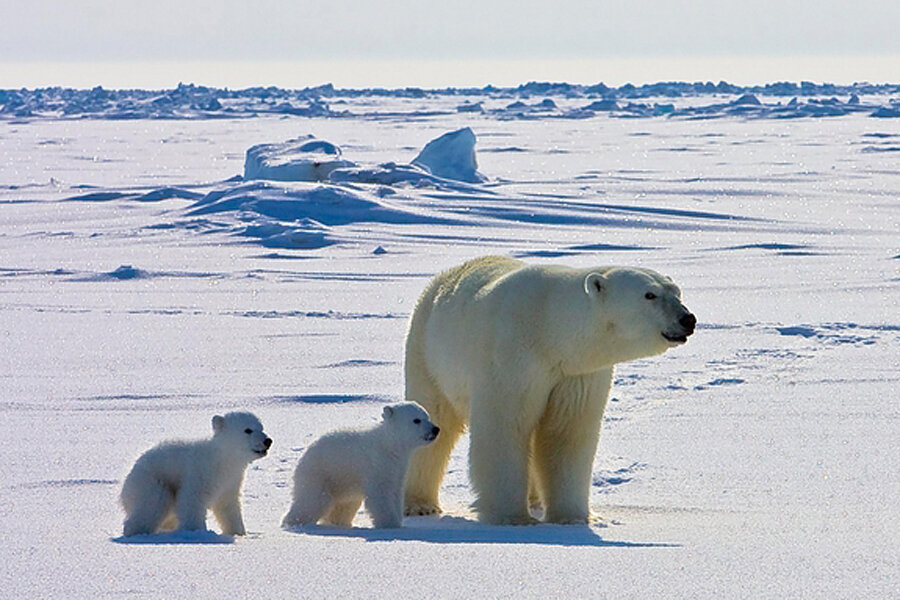What's it like to be a polar bear? Collar cameras offer new perspective.
Loading...
Polar bears nuzzle potential mates and play soccer with a frozen seal carcass in an amazing new video captured by collar cameras attached to the iconic animals.
This rare peek at Arctic life is part of an ongoing research project led by the U.S. Geological Survey that aims to track the health of Alaskan polar bears. The USGS said this is the first point-of-view video ever recorded from free-ranging polar bears.
"None of us have ever seen anything like this before," said Todd Atwood, leader of the polar bear research program at the USGS' Alaska Science Center in Anchorage. "It's a 'gee-whiz' feeling, seeing through the eyes of a polar bear."
The collar cams also serve as fitness trackers for the polar bears: Each collar is equipped with an accelerometer, a device similar to the gadget in a fitness tracker that records a person's movement.
When combined with video, scientists can decode the collar's movement data — whether the bears are eating, hunting, swimming or walking. The information will help researchers gauge how much energy the bears expend during their daily activities. [Gallery: Stunning Photos of Polar Bears in the Arctic]
But the videos revealed more than the bears' calorie count. Some of the behaviors recorded on camera had never been seen before — for instance, one polar bear plunked its frozen seal carcass into the sea.
"These animals are hard to observe in a natural setting," Atwood told Live Science. "This gives us a very unique insight into what they do on a daily basis."
Researchers speculated that the seal-dipping bear might have been warming the icy seal to make it more palatable, or perhaps the bear was playing with its food as part of a mating ritual with a nearby male.
Watching a changing world
USGS scientists are studying Alaskan polar bears to see how the animals respond to changing sea ice conditions. The growing distance between the Alaska coast and summer Arctic sea ice means polar bears have to travel farther, and burn more energy, to reach their traditional hunting areas.
Studies from the research project have found that polar bears are swimming longer distances, fasting for longer periods and spending more time onshore because of the decline in summer sea ice, Atwood said.
The Arctic is warming rapidly due to climate change, and the climbing temperatures are having a complex effect on Arctic sea ice. In some regions of the Arctic, there is less winter sea ice, but in other spots — such as the Bering Sea — there is more winter ice. Overall, though, there is significantly less summer Arctic sea ice now compared to in past decades.
Polar bears were listed as threatened in 2008 on the endangered species list due to the ongoing loss of their sea ice habitat.
This April was the first time the USGS successfully recorded video from polar bears. A trial run in 2013 failed because the collar camera, from a commercial company, froze under Arctic conditions. The batteries failed, and the lens iced over, Atwood said.
When scientists returned this spring, Anthony Pagano, a University of California, Santa Cruz, wildlife biologist who is leading the study, used custom-built collar cameras designed by private contractor Exeye. Pagano attached four collars to female polar bears who live near the southern Beaufort Sea.
The cameras can store 38 hours of video, and are programmed to turn on when temperatures are above freezing, so the lens isn't iced over during filming. The collars drop off after eight to 10 days.
"They worked fantastically," Atwood said. The USGS plans to repeat the collar-cam research in 2015, he said.
Email Becky Oskin or follow her @beckyoskin. Follow us @livescience, Facebook & Google+. Original article on Live Science.
- Polar Bear Wearing POV Cam Eats Seal, Gets 'Frisky' | Video
- Endangered Beauties: Images of Polar Bears
- In Images: Polar Bears' Shifting Diet
- On Ice: Stunning Images of Canadian Arctic
Copyright 2014 LiveScience, a TechMediaNetwork company. All rights reserved. This material may not be published, broadcast, rewritten or redistributed.







